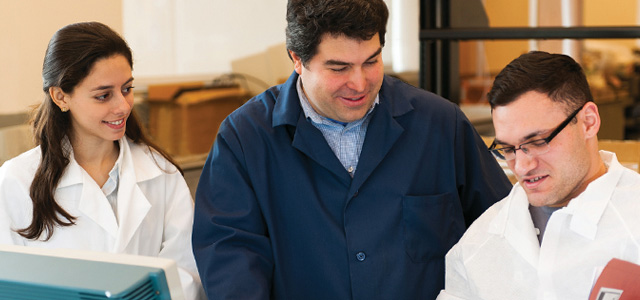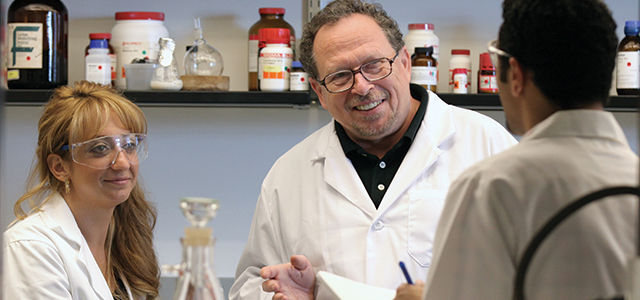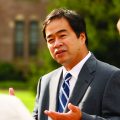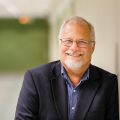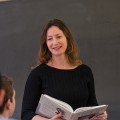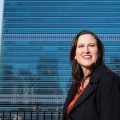Jose Lopez does more than make advances in the newly emerging field of microplasmas, he makes a sometimes intimidating subject accessible for students.
There’s a bolt of pure lightning that plays music in the basement of McNulty Hall.
At least, it looks like lightning. It pulses, and music plays out of the thin air above it. Jose Lopez, the newest addition to Seton Hall’s Department of Physics, shows visitors his plasma speaker with a smile. The 34-year-old assistant professor of physics likes a good attention-grabber.
“In physics, we have very bad PR. We make it seem that it’s not accessible,” he says.
In a field forever dominated by Albert Einstein’s loopy personal style, Lopez is an unexpected twist on the age-old vision of a brainy physicist. The chatty Newark native is warm, amiable and plainspoken. And yet, one of the 20 biggest brains in the state, according to Inside Jersey magazine, is also an expert in a little-known, but potentially up-and-coming field of study called microplasmas.
Lopez creates these tiny plasma reactions in order to assemble chemicals as if they were made of Lego blocks.
That’s not as crazy as it sounds. Most people know there are three states of matter: solid, liquid and gas. Each is defined by the density and arrangement of the atoms within it. Plasma is a fourth state that occurs when gases destabilize. That means their atoms break up into a mixture of charged ions and electrons.
Once free, these ions and electrons can be recombined into something new. Lopez studies ways to control them.
“That’s the whole thing,” says Alfred Freilich, a longtime Lopez collaborator who joined Seton Hall with him in 2011 as a visiting research professor. It’s hard to reliably control plasma. It’s hot — the sun and stars are made of it. And atoms like stability. On Earth, they don’t shift to plasma easily.
Generally, a vacuum is needed to coax them. They shift to it more easily in miniature. At scales of a millimeter or less, chemical elements will become plasma in the open air and at a temperature cool enough to touch.
As a result, there may be a lot of ways to put these tiny plasmas to work. Lopez and Freilich look for them.
For instance, Degrémont Technologies uses their research to increase the amount of oxygen it can turn into ozone inside of school bus-sized microplasma reactors. Municipalities and other groups buy the reactors so they can kill bacteria with ozone rather than chlorine at their water-treatment plants. The ozone is produced on-site because it breaks down soon after it’s created.
The oxygen alchemy is cool, but Lopez uses the reactors to connect more than just electrons and ions.
He also uses them to connect with people. By forcing a lot of tiny oxygen plasmas to create ozone, the reactors remind people that physics doesn’t just explain how the universe works. It also offers keys for controlling it.
So, when Degrémont asked for help on its microplasma reactors in 2005, Lopez opted to make the field a long-term focus. At the time, he was joining the physics faculty at his alma mater, Saint Peter’s University in Jersey City, N.J.
That found the newly minted academic looking for a way to connect with students directly.
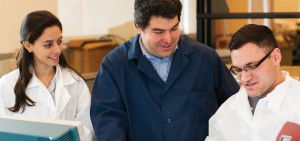 Lopez already knew something about drawing students into science. Kurt Becker, his doctoral adviser at the Stevens Institute of Technology in Hoboken, N.J., noticed that shortly after Lopez arrived in 2000. Becker often opened his lab to local high school and college students looking for hands-on research experience. They all flocked to Lopez.
Lopez already knew something about drawing students into science. Kurt Becker, his doctoral adviser at the Stevens Institute of Technology in Hoboken, N.J., noticed that shortly after Lopez arrived in 2000. Becker often opened his lab to local high school and college students looking for hands-on research experience. They all flocked to Lopez.
“It was almost his natural instinct to take them under his wing,” says Becker.
That’s not surprising. By then, Lopez had been teaching science for years — he tutored the entire women’s varsity basketball team in math and science while a sophomore at Saint Peter’s.
But he did learn some new tricks under Becker, now the associate provost for research and technology initiatives at the Polytechnic Institute of New York University. Becker treated doctoral students like colleagues, not employees.
He encouraged them to explore their own interests, and tried to get them whatever they needed to do it.
“If someone had a good idea, my attitude was: Go try it out,” he says.
Becker’s stance had a long-term effect on Lopez. Nothing is out of reach. Last spring, he applied the theory to one of his first courses at Seton Hall. Rather than limiting his class on waves and oscillations to the university’s labs, he added a set of online video lectures from the Massachusetts Institute of Technology.
The result really stood out to junior Stacie Ballou. The lectures gave her a first-hand look at the type of experiments normally confined to big research universities. “It was a different experience,” she says.
For Lopez, that was the point. Students aren’t unlike the chemicals he assembles in microplasma.
They’re ready to become something new — if you can connect with them.
James Erik Abels, J.D. ’03 is a New York City-based writer and the founder of an Internet software start-up.

